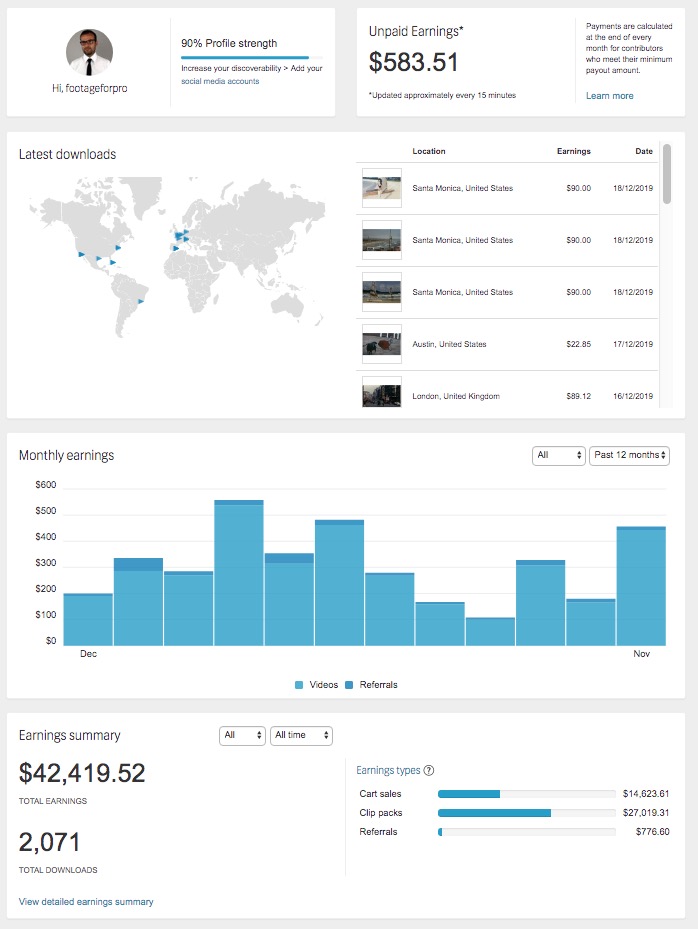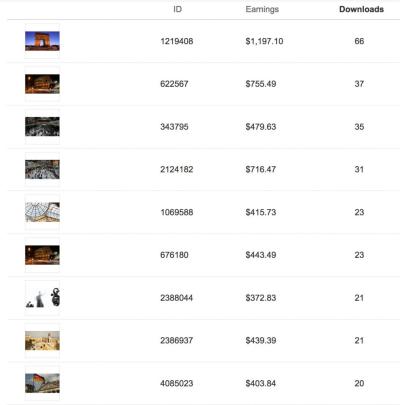If you’re passionate about photography and looking for a way to turn your hobby into a source of income, Shutterstock might just be the platform you need. Shutterstock is one of the biggest and most popular stock photography websites worldwide, offering millions of images, videos, and music clips to millions of customers. For photographers, it provides a fantastic opportunity to showcase their work and earn money whenever someone downloads their images. The platform’s contributor program is designed to make the process simple and rewarding—whether you’re just starting out or already a seasoned pro. By uploading your photos, you can reach a global audience and generate income passively, making it an attractive option for many photographers seeking extra cash or a full-time income.
Understanding Shutterstock’s Payment Structure and Royalties

When it comes to earning money on Shutterstock, understanding how their payment structure works is key. Shutterstock operates on a royalty-based model, meaning you earn a percentage of the revenue generated from each download of your images. The amount you earn per download depends on your contributor level, which is primarily based on your total lifetime earnings and the number of images you’ve uploaded.
Here’s a quick breakdown of how royalties typically work:
- Royalty Rates: Your earnings per download can range from about 15% to 40% of the sale price, depending on your contributor level and the type of license purchased (Standard or Enhanced).
- Contributor Levels: Shutterstock offers different tiers such as Standard, Elite, and Contributor, with higher tiers earning higher percentage rates as you meet certain milestones.
- Payment Thresholds: You need to reach a minimum earning threshold (usually $35) before you can withdraw your earnings via PayPal, Skrill, or bank transfer.
It’s also important to note that Shutterstock’s licensing options influence your earnings. Standard licenses, which are used for most typical uses, pay lower royalties, while Enhanced licenses, which are purchased for more extensive or commercial uses, pay higher royalties.
Furthermore, Shutterstock offers a transparent dashboard where you can track your downloads, earnings, and performance over time. While payouts can vary based on sales volume and license types, many contributors find that consistent uploading and marketing can lead to a steady stream of income. Remember, the more high-quality, unique photos you upload, the more chances you have to earn. So, understanding the payment structure helps you strategize and maximize your earnings on this platform.
Factors That Influence Your Earnings as a Shutterstock Contributor
So, you’ve started uploading your photos to Shutterstock and are eager to see how much you can make. Well, the truth is, your earnings aren’t just a flat rate; they depend on several important factors. Let’s break down what affects your income so you can optimize your contributions and maximize your earning potential.
1. Contributor Level: Shutterstock has a tiered contributor program based on your lifetime earnings. As you earn more, you move up levels—Standard, Advanced, and Elite—which come with higher royalty rates. So, the more you sell, the better your percentage gets!
2. Image Quality and Relevance: High-quality, sharp, and unique photos tend to sell better. Also, images that match popular search terms or current trends are more likely to be purchased. Investing time in editing and keywording your photos effectively can make a big difference.
3. Image Category and Subject Matter: Some categories tend to sell more than others. For example, business, technology, lifestyle, and healthcare images often see higher demand. Niche or highly specialized photos can also fetch a premium if they fill a specific need.
4. Licensing Type: Shutterstock offers two main licensing options—royalty-free and rights-managed. Most contributors earn royalties from royalty-free images, which are more popular with buyers. However, rights-managed images can sometimes command higher prices if they’re unique and in-demand.
5. Number of Downloads: Naturally, the more your images are downloaded, the more you earn. Consistently uploading fresh, high-quality content can help keep your portfolio active and increase your sales volume.
6. Contributor Promotions and Sales: Shutterstock occasionally runs promotional campaigns or offers discounts, which can boost the visibility of your images. Participating actively and understanding how to optimize your keywords and titles can help your photos ride these waves of increased traffic.
In essence, your earnings as a Shutterstock contributor are a mix of your effort, strategy, and a bit of luck. By focusing on quality, relevance, and consistent uploads, you can increase your chances of earning more over time.
Average Earnings for Shutterstock Photographers
Curious about how much you might actually make? Well, earnings can vary quite a bit depending on your activity level, portfolio size, and niche. But let’s look at some general figures to give you a ballpark idea.
For new contributors just starting out, earnings are typically modest. You might earn anywhere from $0.25 to $1.00 per download during your initial months. As you gain more experience, improve your keywords, and increase your portfolio size, your earnings can grow significantly.
Here’s a rough breakdown of what you might expect based on contributor level:
| Contributor Level | Average Earnings per Download | Potential Monthly Income (with 100 downloads) |
|---|---|---|
| Starter | $0.25 – $0.50 | $25 – $50 |
| Contributor | $0.50 – $1.00 | $50 – $100 |
| Elite | $1.00 or more | $100 or more |
Of course, these are just ballpark figures. Some top contributors report earning thousands of dollars monthly, especially if they’ve built a large, diverse portfolio and their images are consistently in demand. On the other hand, many hobbyists earn a few dollars here and there.
Keep in mind that Shutterstock’s royalty rates are also influenced by your contributor level and the type of license sold. As you become more experienced and your images become more popular, your earnings per download can increase. Plus, consistently uploading fresh, high-quality content is key to boosting your overall income.
So, while there’s no guaranteed income from Shutterstock, with dedication and strategic effort, many photographers turn their stock photos into a reliable source of passive income. The key is patience, continuous improvement, and understanding what the market needs.
Tips to Maximize Your Income from Shutterstock Photos
So, you’re ready to turn your photography passion into a steady income stream on Shutterstock? That’s fantastic! But, like any other platform, standing out and earning well requires a bit of strategy. Here are some tried-and-true tips to help you maximize your earnings from your Shutterstock photos:
Focus on High-Demand Topics
Research what buyers are currently looking for. Trends change, but some themes always perform well—think business, technology, health, travel, and lifestyle. Use Shutterstock’s popular search queries and trending categories to guide your shoots. Creating images that match current demand increases your chances of sales.
Upload High-Quality, Unique Content
Quality beats quantity every time. Make sure your photos are sharp, well-composed, and properly lit. Avoid overused or clichéd images; instead, aim for unique angles or perspectives. Originality can help your photos stand out in a sea of content, leading to more downloads.
Optimize Your Keywords and Descriptions
Think of keywords as the GPS to your photos. Use relevant, specific keywords that accurately describe your image. Include synonyms and related terms to broaden your reach. Well-crafted descriptions and tags make it easier for buyers to find your images, increasing the likelihood of sales.
Consistency Is Key
Uploading regularly keeps your portfolio fresh and active. Shutterstock’s algorithm tends to favor contributors who upload consistently, helping your images appear more often in search results. Set a manageable goal—whether it’s weekly or bi-weekly uploads—to stay engaged and keep your portfolio growing.
Build a Diverse Portfolio
Offer a variety of images to attract different types of buyers. Include both wide shots and close-ups, different themes, and diverse models or settings. This diversity not only broadens your appeal but also increases your chances of matching specific buyer needs.
Engage with the Shutterstock Community
Join forums, read blogs, and participate in discussions. Connecting with other contributors can give you insights into what’s working, upcoming trends, and tips on improving your submissions. Plus, sharing your experiences can motivate you to keep improving and uploading new content.
Monitor Your Performance and Adapt
Use Shutterstock’s dashboard to see which images perform best. Take note of the themes, styles, or keywords that generate the most income. Use this data to refine your future uploads, focusing on what works best for your audience.
Remember, building a successful Shutterstock portfolio takes time and persistence. But with these strategies in your toolkit, you’ll be well on your way to earning more from your photography!
How to Get Started as a Shutterstock Contributor
Getting started on Shutterstock might seem a bit overwhelming at first, but it’s actually pretty straightforward. Here’s a simple step-by-step guide to help you kick off your journey as a contributor:
Step 1: Create Your Account
Visit the Shutterstock Contributor website and sign up for a free account. You’ll need to provide basic information like your name, email, and agree to their terms. Once registered, you can start preparing your portfolio.
Step 2: Understand the Requirements
Before uploading, familiarize yourself with Shutterstock’s content guidelines. They prefer high-resolution images, with a minimum of 4 megapixels. Avoid watermarks, logos, or copyrighted material that you don’t have rights to. Make sure your photos are well-edited, properly exposed, and free of noise or distractions.
Step 3: Prepare Your Photos for Submission
- Crop and resize images to meet Shutterstock’s specifications.
- Apply any necessary color corrections or retouching.
- Choose compelling titles, descriptions, and keywords to accurately describe your images.
Step 4: Upload Your Photos
Use the contributor dashboard to upload your images. During the upload process, add titles, descriptions, and keywords. Take your time to craft descriptive and relevant metadata—this is crucial for discoverability.
Step 5: Submit for Review
Once uploaded, your images go through Shutterstock’s review process. Reviewers check for quality, originality, and compliance with guidelines. This process can take a few days. If your images are rejected, don’t get discouraged—review feedback carefully, make improvements, and try again!
Step 6: Start Earning
After approval, your photos will be available for licensing. Shutterstock will track downloads and earnings, which you can monitor through your contributor dashboard. The more high-quality, keyword-optimized images you upload, the more potential sales you’ll generate.
Pro Tips for Beginners
- Start with a niche you’re passionate about—your enthusiasm shows in your work.
- Study successful portfolios to understand what sells well.
- Stay consistent and keep uploading new content.
- Engage with the community and learn from other contributors’ experiences.
Embarking on your Shutterstock contributor journey is exciting! With patience and dedication, you can build a thriving portfolio and start earning from your photos sooner than you think. Happy shooting!
Conclusion and Final Thoughts on Shutterstock Photo Earnings
In summary, earning from your photos on Shutterstock can be a rewarding experience, but it requires consistent effort, quality images, and strategic uploading. The platform offers multiple income streams, including royalties based on downloads, exclusive versus non-exclusive content, and potential bonuses for top contributors. Typically, contributors earn a percentage of the sale price, which varies depending on their contributor level and whether they hold exclusive rights. On average, contributors might earn anywhere from a few cents to a few dollars per download, with top creators making significantly more due to higher sales volume and premium content.
It’s important to understand that your earning potential depends on several factors:
- Image quality and relevance: High-quality, trending, and niche-specific images tend to sell better.
- Consistency: Regularly uploading new content increases visibility and sales opportunities.
- Keyword Optimization: Proper tagging helps your images reach the right audience.
- Contributor Level: Higher levels unlock better royalty rates and more earning opportunities.
While Shutterstock can be a lucrative platform for passionate photographers and designers, it’s essential to have realistic expectations and view it as a potential supplementary income source rather than a full-time income overnight. Success often hinges on dedication, continuous learning, and adapting to market trends.
Ultimately, with perseverance and strategic effort, Shutterstock can serve as a valuable platform to monetize your photography skills and grow your earnings over time.


